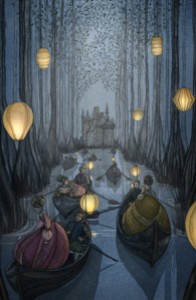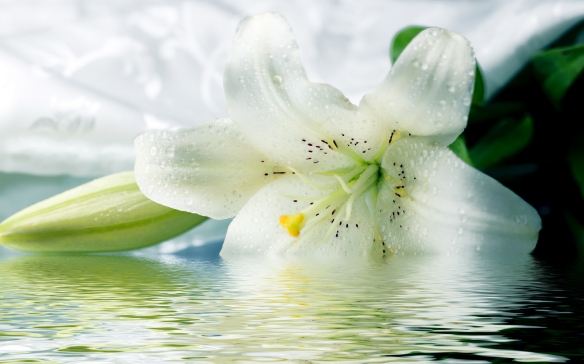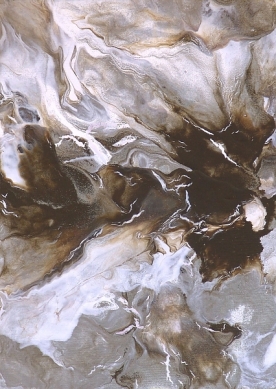Once upon a time, in a land far, far away, there were three princesses who tiptoed out in secret every night to dance until dawn. Lily was the eldest and dominant sister. She wore a white dress but her green and red hair reflected her spicy nature. Then came the young twins, Tuberose and Jasmine: Tuberose was tall, elegant, also dressed in white, but had mint and black hair to reflect her slightly smoky, mentholated, chilly scent; Jasmine was short, round and sweet, bedecked in floaty, gauzy, white and yellow velvet.
Every night, they were secretly escorted to the shores of a magical tropical island by a boatman called Vanilla. He was a husky, swarthy brute of a man who smelled faintly of the buttery coconut that he’d picked up in his travels to Tahiti. He could be domineering, speaking as loudly as the sisters, but he could also be extremely soft. It all depended on his mood, as he watched the sisters dance the night away. They looked like petals floating in the wind, leaping with airy and light footsteps until they were a blur of white. Though they started on a powerful, strong note, they soon tired and their steps softened until they faded away in muted exhaustion. Sometimes, they danced for 4 hours, sometimes for 6. It all depended on how much of the magic potion they had drunk — but they were always a force of femininity, representing both delicacy and full-blown diva power. The boatman had a name for them: Lys 41.
Lys 41 is one of three new scents released last month, in May 2013, by Le Labo. Two of them — Lys 41 and Ylang 49 — will join the permanent collection and won’t be exclusive to any one city. If you’re new to Le Labo, it is a niche perfume house who hand blends your perfume for you at the time of purchase and who uses numbers in the name of their scents to reference the amount of ingredients in that perfume. So, the eau de parfum, Lys 41, purportedly has 41 notes. As with all their fragrances, the name may not actually correlate to what the perfume smells like. Now Smell This explains more:
In each case, the number in the fragrance name refers to the number of notes that make up the scent’s composition, and the name is taken from the ingredient in the highest concentration; to take one example, Jasmin 17 has 17 ingredients, with jasmine being in the highest concentration. The names are thus not necessarily related to what the fragrance is meant to smell like.
Lys 41 was created by Daphne Bugey and, out of the 41 notes, the only ones we know about are:
Lily, jasmine, tuberose absolute, tiare, warm woody notes, vanilla madagascar and musks.
Lys 41 opens on my skin as a stunningly beautiful, completely diva-like, big white floral that is surprisingly delicate and a touch green as well. Like the oldest princess in charge in my version of the Grimm fairytale, it’s all about the lily as the dominant note in those opening minutes. She’s fresh, airy, slightly green, very diaphanous and endlessly white. She is trailed by her two white sisters, but the shock comes when the boatman — Vanilla — muscles his way past them to dance with Lily.
He’s a big, brash, bold, hearty fellow who appears almost butch in comparison to his dainty companions. I have to admit, I am very finicky about my vanilla; I like it in a benzoin form or as a light, subtle touch, but almost never as true vanilla-vanilla. And I certainly don’t like it to be so buttery that it takes on an almost coconut-like tropical hue. Which is what our burly boatman does in this story, thanks to the indirect effect of the tiaré flower. As Fragrantica explains, tiaré is a type of Tahitian gardenia with a tropical aroma that “often reminds us of suntan lotion in perfumes due to its frequent use in such products; monoi essence is made by macerating tiara in coconut oil.” For me, the beauty of Lys 41 lies in its white-green notes, not in its more tropical, buttery, coconut undertones. And, yet, the boatman called Vanilla is an odd one. At times, he is so subtle and soft, he’s absolutely perfect. The whiff of tiaré’s coconut vanishes, and Lys 41 becomes a perfect dance of just the three sisters with him providing only a delicate support in the background. Frankly, I wish he (and the bloody tiaré he’s infused with) would stay there and stop joining the others, but he doesn’t. Back and forth, the vanilla note in Lys 41 changes character.
Lily may be the head princess, but the other florals certainly dance alongside her. Ten minutes into Lys 41’s development, Jasmine starts to be a little less shy. Her appearance, in conjunction with her twin, Tuberose, inevitably brings to mind Gardenia as a lost sister in this dance. True gardenia, and not the Tahitian version called Tiaré. Yet, the whiff or visual of gardenia is just a subtle mental flicker. The more interesting thing is the tuberose which starts to take on a subtle camphorous note. In concentrated or absolute form, as it is here, tuberose can have mentholated aspects as it did in Serge Lutens‘ famous Tubereuse Criminelle. Lys 41, however, has none of the gasoline, rubbery, almost black, tarry, asphalt qualities of the Lutens fragrance. Instead, the note feels more chilly and, increasingly, a little bit smoky.
The combination of notes is a marvel of white, a blur as softly airy, diaphanous and delicate as a prima ballerina’s white skirts. In fact, it is really hard not to think of a row of dancing ballerinas when you wear Lys 41. Yes, on some levels, it is a powerhouse white floral and, yet, it isn’t indolic, over-ripe, over-blown and languidly extreme. The green and spicy nuances to the lily prevent the indoles from feeling over the top. Lys 41 is like Fracas in its white intensity, but it’s a surprisingly airy perfume. The best description of it comes from Luckyscent who writes:
While this is definitely not light in the sense of being understated, it is light in the sense of being airy and buoyant. It is an expansive airiness – a large billowy cloud of something weightless: rows and rows of ballerinas spinning in tutus, hundreds of white butterflies being released into the air, an impossibly long chiffon veil floating in the wind.
Absolutely brilliant and right on the nose! (And, see, they thought of ballerinas, too! I’m telling you, this perfume evokes the entire ballet corps of Swan Lake leaping in the air!)
Lys 41 remains essentially unchanged for the first two hours. There was, on my first test, a growing note of pepperiness underlying the notes that didn’t feel like ISO E Super (which Le Labo apparently loves to use) because it wasn’t antiseptic or medicinal. Instead, it was just simple “pepperiness.” Yet, I got such a raging migraine, I felt as though someone had taken a cleaver to my head. Oddly enough, during my second test, I actually applied a greater quantity of Lys 41 and… no headache. There also was no pepper nuance that time, but simply the chilly, almost peppermint-y smokiness from the tuberose absolute. I have no explanation.
Regardless, Lys 41’s gorgeous floral bouquet remains unchanged until the start of the third hour when the perfume turns into abstract. Lys 41 is now a skin scent and none of the three dancing sisters is distinguishable in an individual capacity. Rather, they are a blur of soft, delicate white. There is also the perfect touch of vanilla: sheer and evoking the subtle sweetness of a vanilla mousse. The tiaré-coconut and mentholated notes have vanished, and taking their place is a subtle muskiness with a hint of creamy, beige woods. In its final moments, Lys 41 is nothing more than a delicately abstract, nebulous, floral muskiness with a tinge of light soapiness.
I was a little surprised by Lys 41’s longevity. For one thing, Lys 41 is concentrated at 25% perfume oil such that it is really a pure parfum or extrait de parfum in strength. For another, I had read on CaFleureBon that the perfume had “overnight longevity.” Yet, in my first test, Lys 41 lasted a mere 4.5 hours. I was so astonished, I tried it again, applying double the amount of the perfume. This time, the longevity clocked in at 6.5 hours. At least 3.5 hours of that time was spent as a complete skin scent. In my first test, out of the 4.5 hours, 2.5 of them were right on the skin. So, in my opinion, the perfume’s overall sillage is moderate to low, as is the longevity. Yet, in the first 30 minutes, Lys 41 definitely creates a lovely, small cloud around one, wafting about 3 inches above the skin.
One of the best reviews for Lys 41 comes from CaFleureBon, which is the only site I’ve seen thus far to discuss the very subtle, mentholated, smoky note that I detected:
So often with the name of a Le Labo fragrance it is sort of a feint as the note in the name is not the focal point. That is not the case with Lys 41 which perhaps should be written LYS 41 to be completely accurate. The lily is a big old white floral diva in Lys 41 like she knows it’s her name on the label. Perfumer Daphne Bugey creates a ginormous white flower fragrance which at 25% perfume oil concentration is at extrait strength. Often when something is at this concentration it sort of smokes and smolders on the skin. Lys 41 shakes her moneymaker right in front of your nose. The great green floral quality of lily draws you in and quickly it is surrounded with indolic jasmine, tuberose absolute, and tiare. The lily is the lead singer while jasmine adds a bit of low harmony, and tiare the high notes. The tuberose in the form of the absolute adds that camphoraceous quality the best tuberose has in high concentration and that is alto to lily’s contralto. The base is a foundation of woods, vanilla, and musk which you won’t notice for hours after you have this on. The white flowers are in charge and they won’t get off the stage without a fight. I haven’t enjoyed a busty powerhouse white floral like Lys 41 in a long time but this is going to be a summer staple for me.
The Non-Blonde has a very amusing review in which she recounts several people’s experiences with the fragrance, from herself to her friend, husband and brother-in-law. It may be useful for the various comparisons based on skin chemistry and, also, for how men feel about the scent:
It was an unexpected love since I’m not a lily person. I don’t wear Un Lys (Lutens) or Lys Méditerranée (Malle)… but something about Lys 41, the new fragrance from Le Labo, seems to work incredibly well and to gain the approval of friends and husbands, though not everyone liked it on themselves, and my sweet brother-in-law was not amused.
If you ask me, it’s the tuberose. While Lys 41 is chock-full of white flowers, my skin amplifies tuberose and the warm facets of the musky dry-down. The husband found it very sensual and nicely sweetened. On me, that is. His own skin took the jasmine note and shot it to high heaven. However, not even five minutes after spraying the sharp green screech was gone and the orchidy vanilla and fuzzy musk took over. I definitely want to keep smelling Lys 41 on him, and the husband himself doesn’t object, though he says it’s not really his kind of thing. […][¶]
In any case, Le Labo’s newest white floral is lovely. There’s something in the base of both Lys 41 and Ylang 49 that seems to embrace my skin and wrap it in a mohair-like warmth. I love the light twist into vanilla territory in the dry-down which lasts for long hours and projects nicely. I doubt that Lys 41 is office friendly, but I’ll say it’s an incredible date scent.
Obviously, my experience was extremely different in terms of sillage and longevity, not to mention the chilly, slightly smoky nuance I got from the tuberose. Where I think her review is uniquely useful, however, is in the issue of how men may feel about Lys 41. I think a “manly man” like her brother-in-law who prefers more traditional or masculine fragrances would not feel comfortable wearing Lys 41. And if he hate lilies, then forget about it completely! In fact, people of either gender who scream in terror at the thought of any of the flowers in question (you know who you are, you tuberose and jasmine-phobes) should obviously stay far, far away.
I really liked Lys 41 for a variety of reasons. First, I prefer my florals to be super dramatic powerhouse divas; second, I adore lily scents; and third, I am particularly fond of white florals when they have a green, spicy undertone to them. Given my personal experiences with Lys 41’s sillage and longevity (not to mention that headache the first time around), I’m not sure I’d look for a decant, but something about the scent fascinates me and is hard to forget. It’s the sheer delicacy of it all, with the strong mental image of Swan Lake’s entire ballet corps leaping gracefully into the air with skirts like waving petals. It’s the twist on the Brothers’ Grimm tale of the 12 Dancing Princesses. And, lastly, it’s the stunning beauty of the lily note in the first hour.
I think Lys 41 will fit very specific tastes. Those who prefer darkness, woodiness or spice with their florals will be disappointed. Same with those who prefer something less linear and limited in focus. I also think the average man won’t find it to be his cup of tea; Lys 41 definitely skews quite feminine. Yet, for the target audience, I think Lys 41 will be a big hit and extremely popular.

































